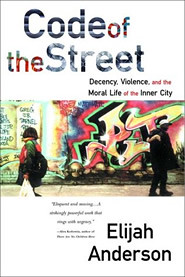Time to brush up on Elijah Anderson

Rob Pitingolo, in "Liberal Places," blogs about a TBD article, "In gentrifying Logan Circle, affordable housing meets hate crimes," about anti-G (gay or gentrification) violence in the 14th and R Street area of northwest DC, by "long time" residents vs. new residents, including "new" gay residents.
While progressives and cultural studies types typically don't think of "spaces of resistance" as being places for non-progressives to resist, they can be (also see "Tea Party").
Elijah Anderson's Streetwise and Code of the Street are books that I joke should be required reading for people new to the city, especially new to areas with significant income disparities, and social, cultural, and racial differences.
Given the influx of people into the city over the past few years, I guess it's time to repeat this.
Anderson had a piece, The Code of the Streets, in Atlantic Magazine six years before he published the book. (There is also a review in Washington Monthly.)
This is an extract from a blog entry from 2006 on the topic of crime:
My hypotheses would be that intensity of street-culture conflict increases with the level of social and economic exclusion, and increased economic disparities within a community. And that the current burst of violent crime coincides with a recognition of greater economic disparity. In DC at least, while certain neighborhoods are experiencing great increases in income and wealth, other neighborhoods are experiencing persistent and greater levels of poverty.
As long as a community doesn't address the deeper programmatic issues involved in addressing the culture and social and economic exclusion issues (quality of schools, safety of the neighborhood, the redevelopment of the neighborhood economy (such as outlined in the textbook Community Economic Development Handbook by Temali) it's likely that crime rates while dropping will hit a ceiling, and of course, will oscillate according to the state of the economy in a particular community.
Click here for the first chapter of Code of the Streets and here for a video illustration of the same chapter, "Down Germantown Avenue," produced by a group of students at Rutgers Unviersity.
Anderson's work is essential reading for understanding the issues involved in public safety. Another interesting take is this article from Mother Jones, "Straight Outta Boston."
Labels: gentrification, invasion-succession theory, public safety, urban sociology, use value vs. exchange value of place



0 Comments:
Post a Comment
<< Home